





















 By Bob Pepalis
By Bob Pepalis
Sandy Springs City Council has approved a $20.1 million contract to construct 1.8 miles of the PATH 400 trail in the city.
The city must pay 20 percent of the contract, with federal transportation dollars funding the rest. The City of Atlanta will pay Sandy Springs for the portion of the trail segment constructed within its city limits.
F.S. Scarbrough was awarded the $20,150,923.94 construction contract. The Fayetteville contractor’s bid was $4.2 million less than the next closest bid, with the highest bid reaching $26.4 million.
Council members and Mayor Rusty Paul expressed concern about the disparity of bids with Scarbrough much lower than the other bidders, whose bid amounts were grouped closer together.
TSPLOST Program Manager Allen Johnson said the project has many walls and bridges to construct. Scarbrough has experience building paths and with site work. Johnson thinks the city got good pricing from the company because it is now entering the market for this type of project. Seeing the bid grouping, he said staff thoroughly checked Scarbough’s qualifications and references.
The Path 400 Trail Extension will
be a walkable and bikeable trail next to GA 400 extending from Loridans Drive to a point in the southern part of the city inside the Perimeter. It will be the northern segment of the 5.2-mile PATH 400. Sandy Springs eventually will have 2.3 miles of the trail extension built.
The funding available will enable the city to build two sections of the trail extension. A third middle section will be built when funds become available, connecting the first two sections being built under this contract.
The southernmost section extends north from Nancy Creek to Windsor Parkway. The northern section will extend north from Ridgeview Park to north of the Glenridge Connector. It will connect to the multi-use trail constructed in the Georgia Department of Transportation’s Transform 285/400 project.
Sandy Springs will use local transportation sales tax revenue to fund its share of the contract. Johnson said the project should take three years to complete. Once necessary state approval has been received, construction is expected to begin in the fall.
Councilmember Andy Bauman said he hoped the city could place signs or branding so residents could see what was coming.








 By Bob Pepalis
By Bob Pepalis
Sandy Springs staff allocated $21.4 million for planned capital projects in the 2025 budget, including a new park and annual repaving projects.
Unless otherwise noted, all meetings are held at Tucker City Hall, 1975 Lakeside Pkwy, Ste 350B, Tucker, GA 30084
• JUNE 3 - 6:30 P.M.
DOWNTOWN DEVELOPMENT AUTHORITY
• JUNE - 7 P.M.
FIRST FRIDAY CONCERT THE WILDFLOWERS Church Street
Greenspace 4316 Church Street
• JUNE 10 - 7 P.M.
CITY COUNCIL MEETING
• JUNE 15
11 A.M.-3 P.M.
WALK FOR THE PAWS
Henderson Park East
4000 Henderson Park Road
• JUNE 19
ALL CITY BUILDINGS CLOSED IN OBSERVANCE OF JUNETEENTH NATIONAL INDEPENDENCE DAY
• JUNE 20 - 7 P.M. PLANNING COMMISSION
• JUNE - 7 P.M.
MOVIE ON THE GREEN MIGRATION Church Street Greenspace 4316 Church Street
• JUNE 26 - 7 P.M.
CITY COUNCIL MEETING
The largest allocation is for the pavement management program at $6 million. Another $1 million from Georgia Department of Transportation Local Maintenance Improvement Grant will be added to the project, according to city manager Eden Freeman.
Freeman said the staff was asking the city council to consider reallocating $750,000 of the budget to City Springs District improvements, creating a capital account for park infrastructure investments or for Fire Station 4.
A $3 million allocation was already proposed for City Springs District improvements, which includes the demolition of existing buildings on cityowned property and for infrastructure.
The city has drained the cistern under City Springs and plans improvements and repairs including installing a liner. An engineering estimate for the work was $1.5 million.
Old Riverside Park, a passive park project along the Chattahoochee River, would get $2.5 million for its construction.
Assistant City Manager Chris Owens proposed that the city outsource a federally-required visual assessment of its stormwater pipes to a company with the necessary equipment and expertise.
He said the city collects data and adds that to its geographic information systems
(GIS) regularly on its stormwater system inventory through its surveys and reports of problems like leaks. This data would be supplemented by getting a contractor to make visual assessments of the stormwater system’s pipes, enabling the city to use all the data to forecast costs for future maintenance, Owens said.
The images and video collected by the contractor would enable the city to become more proactive and address potential problems before pipe failures, he said.
Sandy Springs would not be alone in creating a director of data strategy and analytics although it might be the first city in Georgia to do so, Freeman told city council.
Chattanooga, TN, Austin and Arlington TX, Palo Alto and San Jose, CA, and Alexandria, VA, are among the cities that have adopted similar positions and created such departments.
“This position will be responsible for cohesively pulling together all of our data into one place so that it’s easier for us to get the information that we need and council can make more informed decisions,” she said. “That individual will also be our AI lead helping us look at ways that we should be implementing artificial intelligence into the delivery of city services.”
Freeman said a survey was sent to the city’s senior leadership team to learn more about how they use AI and how they plan to use it. They’ve already drafted a policy on the ethical use of AI and local government based on best practices through the U.S. Conference of Mayors and the Bloomberg Initiative.
Trader Joe’s has plans to open a new store in the Chastain Market shopping center in south Sandy Springs, though no opening date has been set.
The new grocery store will be at 4600 Roswell Road in the former Sprouts location. The center is at the intersection of Roswell Road and Windsor Parkway.
Trader Joe’s website lists the site as an upcoming location. A Trader Joe’s
spokesperson told Rough Draft that the company does not have a timeline for the store’s opening yet.
Chastain Market is a 120,000-squarefoot retail center and mixed-use community, according to the center’s website. It is on a busy commercial corridor at the border of Buckhead and Sandy Springs, adjacent to Chastain Park.
Connolly and Coro Realty acquired Chastain Market in 2022, according to the center’s website.

Some members of the Sandy Springs Development Authority called it “the worst kept secret in Sandy Springs” during their meeting on May 9 to approve a legal document regarding tax incentives related to the company’s lease.
There are three other locations of Trader Joe’s in the metro area, including one further up Roswell Road in Sandy Springs, on Peachtree Road in Buckhead and Monroe Drive in Midtown.


Discover patterns in the world around you through fun and interactive experiences.
• Navigate a 1,700 squarefoot mirror maze





• Find patterns using projections and a two-way mirror
• Expose the mathematical patterns in nature
• Compose your own music using symmetry
For more Brookhaven headlines, subscribe to our
The city of Brookhaven has officially launched its first open container entertainment district.
A ribbon cutting was held on May 24 for the Dresden District, which Mayor John Park said will promote economic development and pedestrian traffic in the heart of the city.
Brookhaven City Council established the entertainment district from Peachtree Road to Camille Drive last August.
Within the Dresden District, pedestrians may walk around with alcoholic beverages from a participating establishment between the hours of 9 a.m. and 10 p.m.
The drink, no more than 16 oz., must be contained and consumed in an official Dresden District cup. Bars and restaurants participating in the Dresden District are required to display a sign at the front door in public view.
Anyone found with alcohol in an unauthorized container or on the street after 10 p.m. could receive a citation or fine.
“The entertainment district will solidify Dresden Drive as the heart of District 2 and Brookhaven, and I’m proud of the independent shops and restaurants that makes this a destination for our community,” Councilmember Jennifer Owens said during the ribbon-cutting.

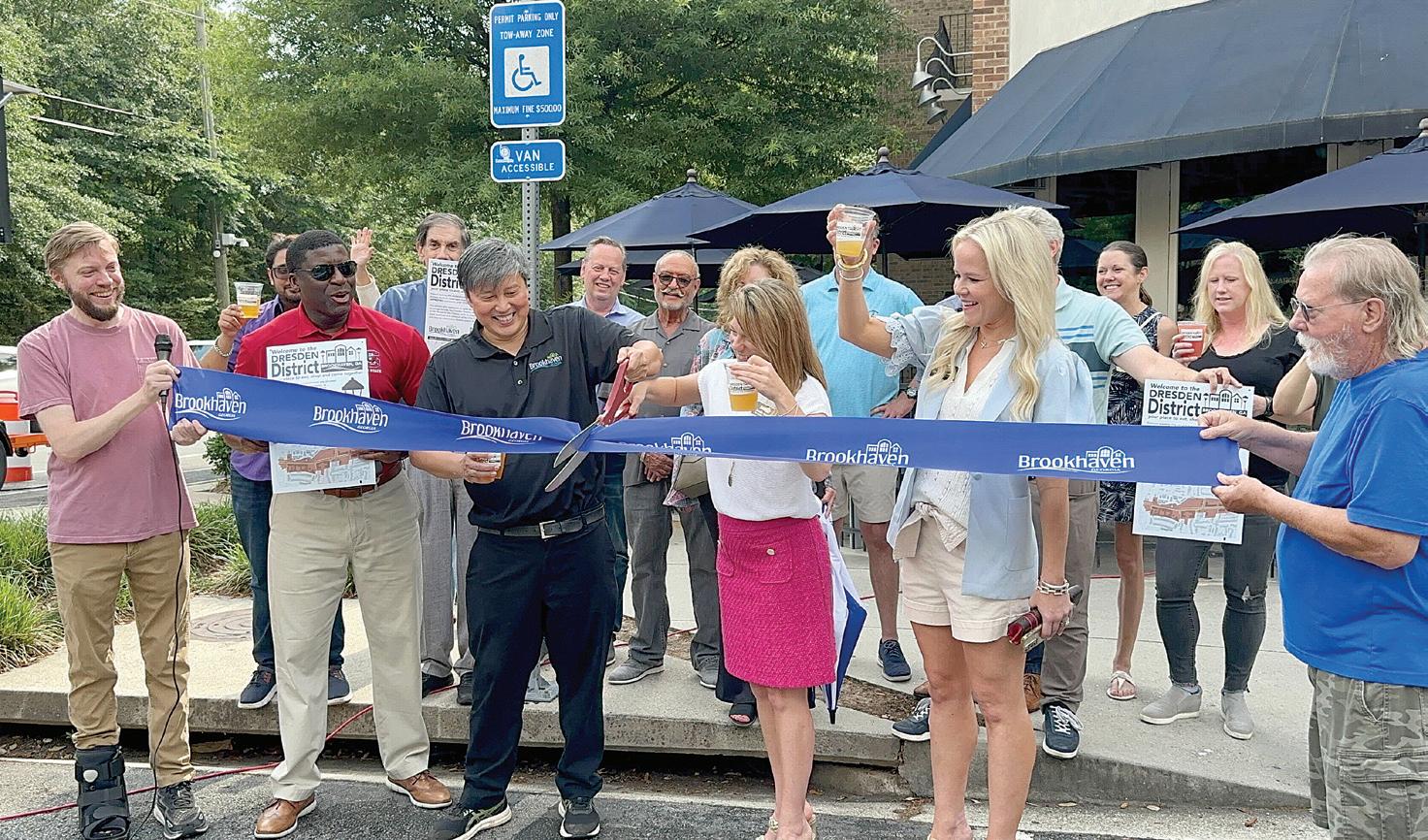
The city of Brookhaven will increase stormwater and streetlight fees to cover rising operation and maintenance costs.
The $107 stormwater fee per household is no longer covering the number of projects the city needs to complete, according to a presentation by Public Works Director Tom Roberts at the May 14 Brookhaven City Council meeting.
City staff is recommending the base fee be increased to $112, plus a new $30/ERU (Equivalent Residential Unit) charge to cover a $6 million stormwater bond. The $30 fee will sunset in seven years.
“We have been trying for quite some time to stay caught up with our high-priority projects, and continue to fall behind because we have new emergencies come up,” Roberts said.
Stormwater emergencies, typically system failures that lead to flooding, detract from the project list and dip into the budget, Roberts said.
proposed is “just a start of addressing our needs.”
“[City Council members] instructed staff to restructure our stormwater to not only make it more equitable, but to also generate more revenue,” Park said. “We’re going to have to raise fees.”
As the city has grown, homes have grown larger while remaining on the same size lot. The lot sizes have much less

A list of 29 stormwater projects was issued in 2022 including the rehabilitation of Murphey Candler Lake spillway and Drew Valley Road drainage improvements. Only 14 projects have been completed on the list.
Mayor John Park said what’s being
impervious area now as opposed to the 1950s homes, said Deputy City Manager Steve Chapman.
Chapman said streetlight district fees will increase for the first time since cityhood was established. The rate structure may be changing in 2025.
“We’re going to make it equitable,” said Chapman.










A new superintendent for Atlanta Public Schools is expected to be made by this fall, and not July 1 as originally planned.
An exact timeline is unknown as the Atlanta Board of Education continues what is now turning into a more than year-long search for the next leader of one of the largest school districts in the state.
Last week, the board said it was accepting new applications for superintendent through May 17. The original deadline was Jan. 12.
The board also said it was extending its contract with Dr. Danielle Battle as
interim superintendent through Dec. 31.
The May 17 extension came a couple of weeks after the board said applicants had until May 2 to apply for the superintendent post. That extension was granted after members learned the names of some candidates were made public — a violation of the process.
“You have a group of parents, you have community people, you have stakeholders, you have people who know people all around the United States and Georgia and Atlanta — and people are having conversations,” Atlanta Board of Education Chairperson Erika Mitchell said.
“I was told this is one of the biggest searches, so people are talking about it,”





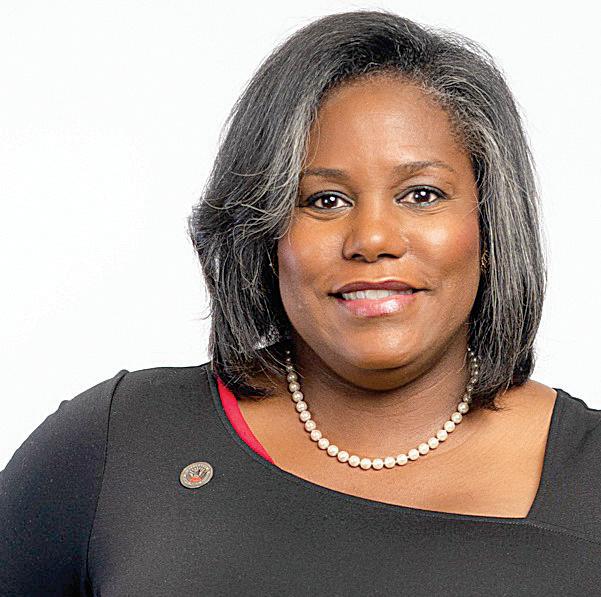
she said. “Conversations were taking place in different areas all over the city, there were candidates that were sharing information with the public, to lobby people to support them for the position.”
The search for a new superintendent began last year after the board voted in June not to renew Dr. Lisa Herring’s contract. Herring served from July 1, 2020, until August 2023.
The school board hired Illinois-based Hazard, Young, Attea & Associates to conduct a national search.
In December, the school board approved what it wanted to see in its next superintendent: a confident and transparent communicator, equity-driven, uses data to make decisions, knows Atlanta and is politically astute, and has experience leading large school districts.
In January, just days before the application process would close for
By Collin KelleyCity of Atlanta Director of Cultural Affairs Camille Russell Love, a fixture at city hall and in the city’s art scene for more than 25 years, has announced she will retire before the end of the year.
The city announced in a press release that a national search will be conducted to find Love’s replacement. Upon the appointment of her successor, Love will assume an emeritus role within the city as the Cultural Affairs Senior Advisor to the Mayor.
“I enjoy serving my city and its residents and look forward to continuing my service,” Love said in a
superintendent candidates to apply, two new school board members were sworn into office — Ken Zeff and Alred “Shivy” Brooks.
Mitchell also started her new position as board chair. The changes interrupted the search process a bit, she said.
Mitchell said she could not say how many people had applied for the job by the Jan. 12 deadline.
Did some people who already applied for the job have to drop out and that is why the searches have been extended?
“No,” Mitchell said.
“We don’t have to restart the whole process.” she said. “The search firm will do the intake and then they provide us the entire pool of candidates that applied since Day One.”
Later this year, the board will interview a slate of candidates and pick up to three finalists. The finalists will then meet with parents, students, and the public who will provide input to a community advisory panel. That panel then makes its recommendations to the board.
“Their feedback is taken at high value, let me just say that,” Mitchell said. “But rest assured, the board makes the decision.”
“I am big on structure and doing things the right way,” Mitchell said. “Our families and our children and our students, our employees, our stakeholders — they are dependent on us to get this right. And they are dependent on us to do it the right way.”
statement. “Although I will miss daily contact and work with the cultural community and emerging artists in this city, I look forward to continuing to work with Mayor [Andre] Dickens in Moving Atlanta Forward.”
Since 1998, Love has been at the helm of cultural programming for the City of Atlanta. As executive director, she has provided strategic direction for various cultural and artistic initiatives, including the Chastain Arts Center and Gallery, the City’s Public Art Program, Gallery 72, Elevate, Contracts for Arts Services, the Cultural Experience Project, and the Atlanta Jazz Festival.
Love has also played pivotal roles on
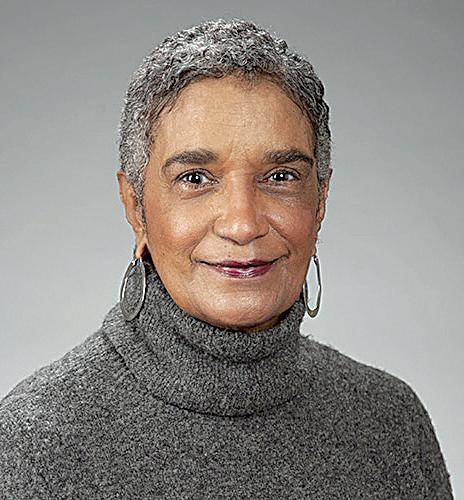
several boards, including the Metropolitan Atlanta Arts Fund, APEX Museum, Piedmont Park Conservancy and the National Black Arts Festival. She has further lent her expertise to esteemed committees such as the Coca-Cola Scholars Foundation National Selection
Committee and the 1996 Cultural Olympiad Committee.
Her dedication and contributions have garnered local, national, and international awards, including the Inspired Cultural Excellence Award (2002) from Omega Media, the Ford Freedom Unsung Award (2012) from Ford Motor Company, the Women in the Arts Award (2012) from Synchronicity, and the Cultural Warrior Award (2013) from the National Black Arts Festival.
Additionally, under her leadership, Artsy recently recognized Atlanta as the #2 Emerging Art Capital to watch in 2024.
“Ms. Love has served the people of Atlanta with the utmost integrity and character. Her creativity and vision have played a pivotal role in elevating the perception of cultural and performing arts in our community,” Mayor Dickens said in a statement.








In 2018, Dunwoody North resident and realtor Matt Weber started a Facebook group with the intent of connecting people in Dunwoody who needed services. Today, Dunwoody Area Community Forum (facebook.com/groups/ dunwoodyforum) has 13,000 followers who weigh in on everyday subjects: lostand-found pets, the appearance of the inflatable dinosaurs that coined the phrase “Dinowoody,” celebrations big and small, and even stray bear sightings. It also contains serious posts that weigh on the residents of the city: the loss of teenagers to the Fentanyl epidemic,




traffic fatalities, information about the Dunwoody police and city government officials, parks bonds, and other issues that affect the lives of many.
Anywhere from 80 to 100 people ask to join the group each day, Weber said. While some are spammers or people trying to advertise their business, most are locals who want to put their fingers on the pulse of Dunwoody.
Weber said he doesn’t think of it as a news source, but a kind of personal blog for those who want to ask questions, those willing to answer them, and those who just want to vent.
“I don’t contribute to the news, I just let the people in the forum do the talking and it’s become so much more than about me,” Weber said. “It seems that anytime something happens in the city, like a new restaurant or High Street opening up, people will get to know about it on the forum.”
Weber, who moved to Dunwoody in 2011, said he felt compelled to start contributing to the life of the city, and put his mark on the community by volunteering at his children’s schools, acting as the emcee of Lemonade Days’ Dunwoody Idol contest and co-chairing the Dunwoody 4th of July Parade.
After the success of the Dunwoody Area Community Forum, Weber started a Facebook restaurant review page, which has about the same number of followers, and sees a robust exchange about new restaurants as well as tried-and-true treasures within the city and outlying communities.
The rules of the DACF are spelled out simply, and sometimes humorously, on
the introduction page: don’t post items for sale, advertise open houses or businesses, “don’t troll others and start drama,” and don’t post your political opinions.
“Nobody cares who you’re voting for!” the page said. “You have a personal Facebook page that is great to post that kind of crap.”
Weber said he has been ridiculed for banning people from the group and deleting incendiary posts but added that anyone who objects to the group or its content is free to leave it.
“A lot of people can be keyboard warriors at home, and when that happens, I’m going to slow things down or take down those posts,” he said. “At first, that was difficult for me because I am such a people pleaser, but now I will not hesitate to kick someone out if they cross the line.”
On the flip side, Weber said he is grateful for city officials like Dunwoody Mayor Lynn Deutsch and Communications Manager Jennifer Boettcher, who often answer citizen concerns within minutes of them being posted.
“Jennifer and Lynn do a great job of handling questions, and if they can’t answer the questions, they will refer them to people who can,” Weber said.
Weber said while he does not benefit financially from moderating the groups or from his “What’s up Dunwoody” podcast, he has connected with people he might not have encountered in his daily life.
“People suggest to me that the Facebook group is a labor of love, and I say, ‘It’s a labor all right,’” he joked. “But I think it’s a powerful tool and I’m glad that it’s around.”


 By Dave Williams
By Dave Williams
The Georgia Department of Transportation (DOT) is moving to expand a network of toll lanes in the Atlanta region that began a few years ago on interstates 75 and 85.
The State Transportation Board voted Thursday to work with the State Road and Tollway Authority (SRTA) to add toll lanes to the top half of I-285 and along Georgia 400 to the North Springs MARTA station.
As with the Northwest Corridor along I-75 north of 285 and a second stretch of I-75 just south of Atlanta, the Georgia Department of Transportation will work in partnership with the private sector on the 285 toll-lane projects. The DOT will coordinate the work, while a private developer will design, construct, operate, and maintain the new lanes, Helen Pinkston-Pope, senior counsel to the DOT, said Thursday.
“We really see the benefits in bringing in the developer early on,” she said.
I-285 perennially ranks among the most congested stretches of highway in the nation, said Tim Matthews, program manager with the DOT division in charge of projects built through publicprivate partnerships. Atlanta’s “Perimeter Highway” sees 250,000 to 300,000 vehicles per day, he said.
As with the earlier toll-lane projects, SRTA will coordinate the financing and collect the revenue from the tolls.
Pinkston-Pope said the DOT will seek bids on the I-285 East Express Lanes project first, covering a stretch from Georgia 400 east and south to Interstate 20. Procurement for the I-285 West Express Lanes – from Georgia 400 west and south to I-20 – will follow, she said. This story comes to Rough Draft via a media partnership with Capitol Beat.























Thursday, July 4, 2024
Theme: “Red, White & YOU” Grand Marshal: David Abes, Founder, Dash Hospitality Group























 By Rough Draft Staff
By Rough Draft Staff
The May 21 Georgia primary ran smoothly, with Democrats and Republicans setting up their candidates for the general election this fall. However, a few key races will face a June 18 runoff, including who will be the next DeKalb County CEO.
Here is a list of metro winners and runoff candidates:
DeKalb County CEO – Runoff
Lorraine Cochran-Johnson 46.3%
Larry Johnson 34.4%
DeKalb County Commission
District 1
Robert Patrick
Fulton County Sheriff Pat Labat
Fulton County District Attorney
Fani Willis, who will face Republican challenger Courtney Kramer in November.
Fulton County Clerk Che’ Alexander
Fulton County Commission
District 4 – Runoff





Natalie Hall 41.56%
Mo Ivory 40.62%
Fulton County Commission
District 6
Khadijah Abdur-Rahman
Fulton Superior Court Atlanta
Judge Scott McAfee
Georgia Supreme Court
Andrew Pinson

State Senate District 36
Nan Orrock
State Senate District 40
Sally Harrell
State Senate District 44
Elena Parent
State Senate District 55 – Runoff
Randal Mangham 31.22%
Iris Knight-Hamilton 22.56%
State House District 42
Gabriel Sanchez
State House District 90
Saira Draper
Atlanta MOST
Voters overwhelmingly supported renewing the one-percent sales tax for water and sewer projects in the city of Atlanta.
Mulberry Cityhood
Voters in Gwinnett County approved the incorporation of Mulberry, which will become the county’s second-largest city.
For more information about the upcoming runoff and general election, visit fultoncountyga.gov or dekalbvotes.com.

Congratulations, graduates! Metro Atlanta families gathered in May to celebrate the graduating class of 2024. Here are the top students honored as valedictorians and salutatorians for local public and private schools.
Atlanta Public Schools
Atlanta Classical Academy
Andrew Heiskell (V) and Lauren Woods (S)
Benjamin E. Mays High School
Forrest Cherry, III (V) and Mishayla Dunlap (S)
B.E.S.T. Academy
Emery Jones (V) and Joshua Salami (S)
Booker T. Washington High School
Kash Walton (V) and Brooke Shelton (S)
Charles E. Drew Charter School
Morgan Walker (V) and Frances Nicolson (S)
Coretta Scott King YWLA
Amariah Caudle (V) and Christina McKelvey-Fludd (S)
Daniel M. Therrell High School
Treyven Jamison (V) and Imani Stover (S)
Frederick Douglass High School
Dontavious Blount Jr. (V) and Chanel Sanchez (S)
George W. Carver Early College
Aynia Grimes (V) and Christina Perry (S)
George W. Carver STEAM Academy
Kiarra Horton (V) and Kamaria Anderson (S)
KIPP Atlanta Collegiate
Kenedie Upshaw (V) Syania Brown (S)
Maynard H. Jackson High School
Liam Smith (V) and Samuel Finlayson (S)
Midtown High School
Shalin Bhatia (V) and Delia Schroeder (S)
North Atlanta High School
Jane Heller (V) and Miah Chien (S)
South Atlanta High School
Zachary Davis (V) and Meilyn Motino (S)
DeKalb and Fulton County Schools
Chamblee High School
Jack Bolte (Magnet Valedictorian), Joshua Jacks (Magnet Salutatorian), Hanna Lin (Resident Valedictorian), and Kai Henderson (Resident Salutatorian)
Cross Keys High School
Exhale Castaneda (V) and Floricela Bravo-Avendano (S)
Decatur High School
Gordon Lichstein (V) and Alexander Gurch (S)
Continued on page 16





Druid Hills High School
Terry Crawford (V) and Micah Burton (S)
Dunwoody High School
Neil Shah (V) and Naomi Kleber (S)
FCS Innovation Academy
Lakshana Ramanan (V) and Tanih Potula & Vihaan Narvekar (S)
Fulton Academy of Virtual Excellence
Andy Qu (V) and Brea Butler (S)
Global Impact Academy
Cyr Kamga (V) and Isabela Damian (S)
Independence High School
Myles Estime (V) Jasmine Valle (S)
Lakeside High School




Shreya Chatterjee and Matthew Phillips (V) and Zachary Murphey (S)
North Springs High School
Christopher Yamamoto (V) and Aoi Chiara Misawa (S)
Riverwood International Charter School
Leah Perlman (V) and Ava Satisky (S)
Tapestry Charter School
Bethlehem Gidey (V) and Richard Holloway, Jr., Bram Rosenblatt, and Violet Todd (S)
Tucker High School
Epherata Zeleke (V) and
Ava-Elizabeth Jacoby (S)
Private Schools
Atlanta International School
Martin Öman (V) and Claudia Canovas (S)
Atlanta Jewish Academy
Zellik Silverberg (V) and Asher Lytton (S)
Greater Atlanta Christian School
Ridgeway Price Ridenour (V) and Akhil Sarikonda (S)
Holy Innocents’ Episcopal School
Colin Welden (V), and Hun Chi (S)
Holy Spirit Preparatory School
Alexia Riley (V) and Marlyn Pineda (S)
The Lovett School
Helen Darby Sands (V) and Bella Hope Infante (S)
Marist School
Alec Issa (V) and Brennan Ujda (S)
Mount Vernon School
Bennett Bogdanchik (V) and Chase Perry (S)
Pace Academy
Morgan Goldstrom (V) and Brody Matthias (S)
The Weber School
Reese Oberkfell (V) and Ava Halpert & Rany Granath (S)
Wesleyan School
Josh Kavel (V) and Kallaghan Freeman (S)
The Westminster School
Albert Tang (V) and Bobby Xia (S)
Woodward Academy
Rishabh Jain, Aneri Patel, Anna Schwartz (V) and Clary Dunaway (S)





Sandy Springs stands at a pivotal moment in our city’s economic journey.
We are home to large and influential multinational corporations, exciting startups, and regional companies that employ thousands of people and drive our economy. We also have entrepreneurs and small business owners who operate the local shops and restaurants we frequent in our everyday lives and who are the backbone of our community.
As a City Councilman and recently appointed Vice Chair of the Sandy Springs Development Authority, looking ahead I see many opportunities. Notably, we must advance Phase 2 of our City Center; redevelop outdated and obsolete commercial properties; rejuvenate Sandy Springs’ North End; and address the looming commercial office market crisis.
Long before our City Center’s inception, I co-founded the Sandy Springs Farmers Market, transforming the dilapidated Target parking lot into a
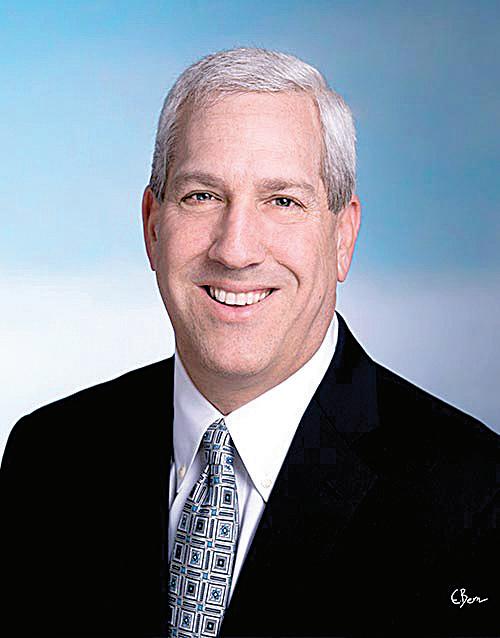
thriving community space on Saturday mornings. Now in its 15th season, the farmers market, along with other events, concerts, and festivals in our City Center, epitomizes our residents’ desire for a central hub offering a lively gathering space for entertainment and opportunities to support local shops and restaurants.
While our City Center has flourished,
there is still work to be done. For Phase 2, it is clear our residents want a balance between growth and preserving our community’s character. I have heard repeatedly they want an emphasis on connectivity, walkability, green space, and public art. They desire more owneroccupied housing and a “village feel” with locally inspired retail shops and restaurants, featuring outdoor dining and open, connected social spaces. And they want it to be safe.
Learning from the experiences of neighboring communities, we must recognize the need for thoughtful planning and careful oversight of nightlife to ensure a vibrant, yet safe and family-friendly environment for all to enjoy.
Beyond our City Center, opportunities for redevelopment in Sandy Springs abound, especially the commercial strip shopping centers and multifamily residential complexes that are past their useful life or beyond repair.
We should encourage and incentivize

Your donations help us provide:
• Educational scholarships to officers and their immediate families
• Emergency financial assistance for catastrophic events or illnesses
• Equipment that enhances the safety of officers and the community
Over the past 7 years, the foundation has donated over $450,000 to support officers and their families as well as the Brookhaven Police Department. This includes over $300,000 for tuition assistance and emergency funds, as well as the purchase of one drone and four K9s.



The Mission of the Brookhaven Police Foundation is to support the Brookhaven Police Department in their efforts to enhance the safety of the City of Brookhaven.
the redevelopment of these older properties, and in the case of apartment complexes, hold property owners and managers accountable to ensure that all residents have access to safe and wellmaintained housing.
Sandy Springs’ north end presents a prime opportunity for new investment and redevelopment. By directing city resources and economic incentives here and engaging all the stakeholders, we can cultivate a more vibrant community, enriching residents’ lives with diverse amenities and opportunities for shopping, dining, and quality housing, all within a safe and welcoming environment.
Lastly, the aftermath of the COVID-19 pandemic has presented unprecedented challenges for our commercial office sector, with vacancy rates soaring and some office buildings facing obsolescence and possible foreclosure.
We should view this crisis as an opportunity to collaborate with property owners and all stakeholders in our community to creatively reimagine and repurpose these properties. By transforming them into mixed-use developments or innovative working spaces accommodating forward-thinking businesses, we can better meet the diverse and changing needs of our community. The message should be clear: Sandy Springs is open for business, and we welcome new investment in our city!
As we embark on these ambitious endeavors, our commitment to quality of life for all who live and work in Sandy Springs must be resolute.
We must aspire to attract a new generation of young people and families who will drive our future by supporting our schools, workforce, and local economy. We must be unwavering in our efforts to maintain Sandy Springs as an attractive, exciting, and safe community for all who call it home.
And as we navigate this journey, transparency, community engagement, accountability, and fiscal responsibility must be paramount.
Together, we can shape a future that reflects the absolute best of who we are, and all that we aspire to be.

ABOVE THE WATER LINE
 Sally Bethea
Sally Bethea
‘If Georgia’s environmental experts determine it’s safe, I’ll support it,” paraphrases a typical remark from local and state officials when faced with important decisions on issues that range from mining at the edge of the Okefenokee Swamp to the disposal of toxic coal ash. Sounds like a reasonable approach.
We should expect our state environmental agency to have the capacity, resources and institutional knowledge to thoroughly evaluate projects that will affect Georgia’s air, land, and water—and then inform decision-makers. Sadly, that is not the case.
When I became the founding director of Chattahoochee Riverkeeper, thirty years ago, the Georgia Environmental Protection Division (EPD) staff were, for the most part, well-credentialed and science-focused; they frequently helped me understand the more complex elements of their technical work.Their conclusions and recommendations were not always supported for political reasons (more about that later), but the career staff took their work seriously.
At that time, the state legislature (read: the governor) supported an adequate, if not robust, annual budget. EPD employed more than 900 staff, including experienced engineers, chemists, biologists, hydrologists, modelers, geologists, educators, and more.
Today, EPD is a shadow of its former self in numbers and expertise. In the past twenty years, the agency has been decimated by meager budgets, low employee pay, and high turnover rates. Career employees have retired or moved to better-paying jobs, draining virtually all institutional memory. New hires stay just a few years and move on.
Adjusted for inflation, EPD’s budget has been slashed by 30 percent from 2013 to 2024, and the staff has shrunk by about 150 employees. As Georgia’s population has grown by three million people and revenues have doubled since 2000, sprawling development is increasingly impacting water supplies, air quality, green space, and the coast.
When I hear people say: “Let the environmental experts at EPD determine if it’s safe to mine near the Okefenokee,”—an international treasure whose protection from mining has been strongly supported by multiple federal
agencies and more than 100,000 public comments—I don’t know whether to laugh or cry.
Dirty DozenIncreasingly ardent calls for less government and less regulation found receptive ears in the Perdue, Deal, and Kemp administrations over the past two decades. As a result, EPD continued its downward spiral in capacity and effectiveness; morale
consequences. When we fail to plan for growth; when we don’t enforce existing laws to protect our water resources; and when we provide anemic funding for the state agency charged with protecting the state’s natural resources, economic development inevitably impacts those resources upon which we all depend.”
Like its predecessors, this year’s Dirty Dozen report describes EPD’s most glaring failures to fully carry out its responsibilities under clean water

tanked. Recently, Gov. Kemp used Georgia’s staggering revenue surplus to give all state employees a salary boost; however, the improved pay levels are still inadequate to retain highly qualified staff and seasoned leadership at EPD. No comprehensive plan is in the works to bring the environmental agency back to its earlier strength and effectiveness.
As the Georgia Water Coalition notes in its 2024 Dirty Dozen Report: “Our state proudly touts itself as the No. 1 state to do business, but that success in economic development is not without its
ever called him back, not that day or any other day. A holiday weekend was approaching and they were apparently “short-staffed.” If the same situation had occurred twenty years ago, EPD experts would have responded immediately and taken action.
There’s a second—even more significant—reason that Georgia is failing to safeguard our environment while boosting the economy: an outcome that is not only possible, but essential. It’s the composition of the governorappointed Board of Natural Resources (Board): currently eighteen individuals who make final decisions about environmental permits, regulations, policies, and staffing.
You might expect this group (the bosses of the EPD) to have at least some environmental expertise. They do not. There is not a single scientist, environmental engineer, ecologist, wildlife expert, or conservationist on the Board. A coincidence? Hardly.
The board’s expertise lies in poultry processing, real estate, construction materials, law enforcement, nursing homes, road paving, health services, car sales, and insurance. With fourteen white men, two white women, and two non-white men (neither African American), the Board looks nothing like Georgia’s growing and diversifying population. All have been major campaign contributors to Kemp and his two predecessors—of course.
Political capture has been defined as “a type of systematic corruption where narrow interest groups take control of institutions and processes in which public policy is made, directing public policy away from the public interest and instead shaping it to serve their own interests.”
laws and meet public expectations. Safeguarding the environment, while building the economy, is simply not a priority for the Kemp administration or its legislative leaders.
When Chattahoochee Riverkeeper’s Jason Ulseth discovered that Fulton County was releasing millions of gallons of partially treated sewage into the Chattahoochee River National Recreation Area last summer—an obvious and serious public health threat—he immediately called EPD’s emergency response team. No one
In 1999, then-Gov. Roy Barnes appointed me to the Board for a sevenyear term. It was a highly enlightening (and stressful) period of my life. At the time, there were several other conservation-minded and knowledgeable members, also appointed by Barnes and his predecessor Zell Miller. By the late 2000s, there were none. Like EPD, the Board of Natural Resources has been purposefully handicapped in its ability to ensure clean water, clean air, and toxic-free land for all Georgians.
Gov. Kemp has reportedly said protection for Georgia’s environment is key to economic development, but his budget priorities and Board appointments argue otherwise.













As Stage Door Theatre enters its 51st season, it will continue to focus its reach beyond its physical location into the community.
Producing Artistic Director Justin Ball, who joined Stage Door three years ago, said outreach to surrounding communities and diverse populations “give us a wonderful opportunity to develop life skills through performing arts.”
Those efforts include 10 weeks of summer camp for children from ages 5-12, now in its fourth year, that has had
impressive growth. The first year, 50 campers attended, followed by 207 the following year, and 358 last summer. This year, enrollee numbers have topped 500.
In addition, SDT has formed partnerships with local elementary schools like Dunwoody Elementary and Montgomery Elementary schools to bring workshops onsite. It also has a spotlight series in collaboration with Picadilly Puppets Company, an Atlanta-based touring puppet theatre. Dad’s Garage Theatre, an improv theatre based in the Old Fourth Ward, will have its final performance on June 7 at Stage Door.
There is also two-week Teen Intensive Program in which aspiring performers embark on a journey that begins with auditions and culminates in a final performance. These intensive weeks offer a deep dive into theatre arts, according to its website, “providing valuable skill enhancement, a sense of camaraderie, and unforgettable experiences.”
SDT’s 51st season offerings, which kicks off in September, include five shows, including Agatha Christie’s “Mousetrap,” “Every Christmas Story Ever Told,” “Cry it Out,” “25th Annual Putnam County Spelling Bee,” and “Orange.”
Ball is no stranger to community theater. According to the Stage Door website, he has produced shows and events for Manhattan Theatre Club, Playwrights Horizons, the Writers Theatre, Penguin/ Random House, and Google.
For more than 10 years, Ball taught theatre management and directing at New York University’s Tisch School of the Arts, and most recently, was the managing

director for the Sharon Playhouse and helped “transform a local community theatre into a small professional summer stock theatre.”
Ball said he is proud of Stage Door’s resiliency, especially considering recent local theatre closings after economic difficulties related to COVID-19.
Midway through its 47th season, Stage Door Players was forced to close their doors under the federally mandated quarantine. After emerging from the pandemic, Stage Door, according to its website, “committed to three things: art, community, and Dunwoody.”
“We are most excited that coming out of the pandemic that we are still standing and opening new chapters,” Ball said. “We have a lot of people to thank for that.”
Stage Door is located at 5339 Chamblee Dunwoody Road in Dunwoody, in the same building as the Dunwoody Library and Spruill Center for the Arts.
Visit stagedoortheatrega.org for more information or to buy tickets for the upcoming season.




Joy Lim Nakrin’s mother realized a lifelong dream by creating a rescue farm for horses and other animals in North Fulton.
Nakrin said her mother was an OBGYN providing rural medicine on horseback in the Philippines before her retirement. She immigrated to the United States and the family lived in the Boston area when they started the search for a place to start their rescue farm.
In 2021 the family moved to Milton to realize that dream, finding a place with a strong equestrian community and weather more favorable than the Northeast. That’s where Nakrin, her 72-year-old parents, and her 74-yearold widowed aunt founded Joyous Acres.
Nakrin said they adopted a racehorse, Enduring Honor, from a large thoroughbred shelter for less than the price of a saddle.
“We just bonded, and he’s like my best friend,” she said. “And I retrained him to be a show jumper.”
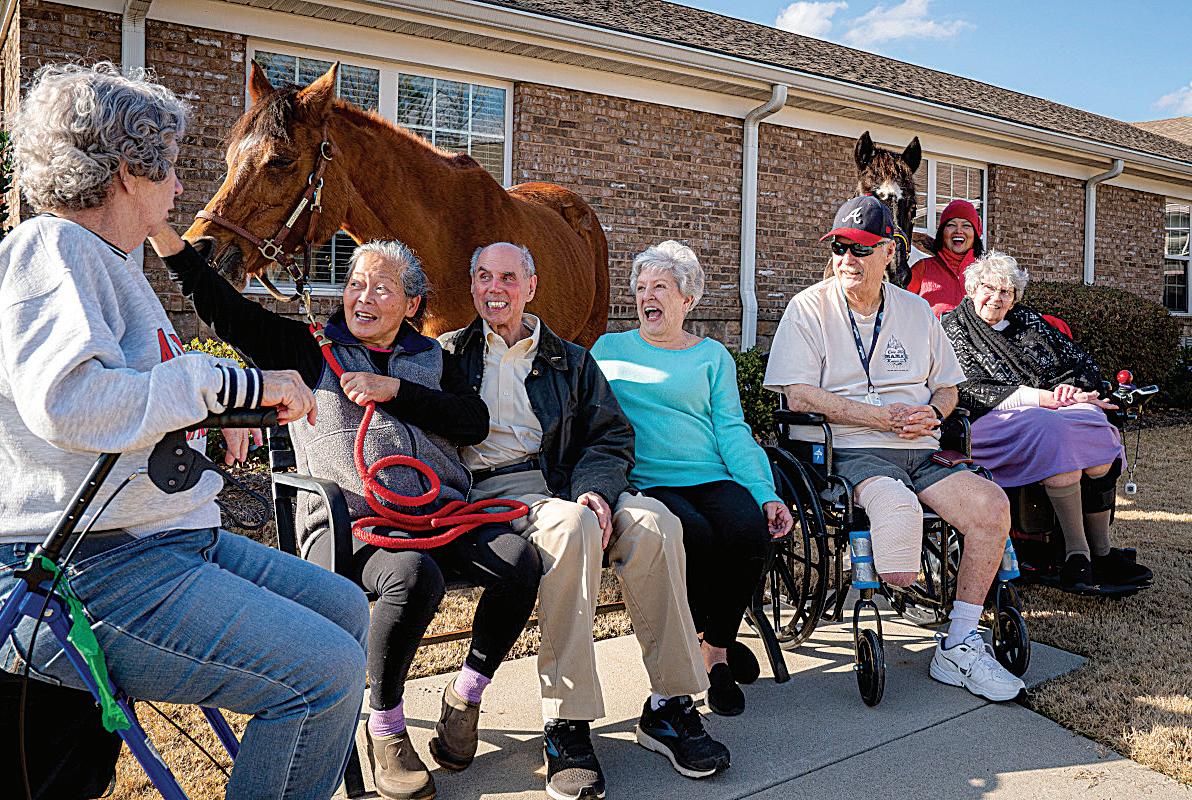
Part of the mission of Joyous Acres is the seniors program founded by her aunt. They invite a few partner nursing homes to bring residents over to visit the horses for pet therapy. They call the program Seniors for Seniors.
“My aunt’s a senior, and she wanted to share this with other seniors, because she fell into a deep depression when her husband died, and the animals were really therapeutic for her,” Nakrin said.
Nakrin, who is a reporter for Atlanta News First, said, to her knowledge, Joyous Acres is the only major equestrian facility and rescue farm run by Asian immigrants.
With the Triple Crown season underway, she said the family was happy to help push for the creation of a thoroughbred division for show jumping in Georgia.
Nakrin said it’s important because when thoroughbreds are pushed out of the industry due to losing races and being slow, injury or old age, the likelihood they will be euthanized is very high. She said 7,500 thoroughbred horses are slaughtered every year in the United States.
The creation of that division may appeal to people who otherwise might buy the pedigree warmblood horses that are preferred for show jumping. Instead, they may consider adopting a healthy thoroughbred and training it to turn it into a show jumper. The national movement is called “Recycle a Racehorse,” she said.
Now they beat $50,000 imported, well-bred warmbloods in show jumping she said, finishing tops in the state in two categories.
Making equestrian sports more accessible for everyone and ridding them of elitism is also part of Joyous Acres’ purpose. Narkin said the perception, and sometimes the reality, is that many people might love horses, but they feel they can’t afford the sport.
They could have purchased every horse, dog, cat, and pig from breeders that they have at their rescue farm, but Nakrin said her family wanted to do their part, so every animal they’ve taken in was either adopted from a large shelter or were owner surrenders.
One of the rescues, Geronimo, is a former Amish workhorse, which suffered an injury while pulling a plow and cart. It was sent off to slaughter, but a rescue group in North Carolina bought him from the slaughterhouse and Joyous Acres adopted him.
“When we met Geronimo, we thought he was just such a gentle soul,” she said, which makes him perfect for the senior therapy program.
Nakrin’s aunt says the old adage, “you get the love that you give,” which has been proven with both Geronimo and Enduring Honor.
“These are horses that haven’t really experienced love before, human affection, and it’s just amazing to see their personalities blossom and see them just transform,” she said.



With patio season in full swing, I wanted to share some of my favorite places to dine al fresco in and around Atlanta. Everyone has their favorite restaurant patio, but the ten patios I’m highlighting on this map always make me happy to dine outside.
From a lively beer garden in the heart of the Summerhill neighborhood to a vibrant restaurant patio for tapas and cocktails in downtown Alpharetta, check out these ten restaurants offering great spaces for outdoor dining.
The Chastain in Chastain Park
Sit on this lovely patio shaded by mature trees for lunch or dinner. Much of the patio overlooks the Michelin Green Star restaurant’s sprawling edible garden. The outdoor lounge has a fire pit and is dog-friendly. Keep an eye out for Bogie, the friendly resident patio cat. thechastainatl. com
Larakin in Midtown
This coffee and wine bar, one block west of Piedmont Park, is perfect for lingering on pleasant days. Seating is all outdoors, too, and the patio is super dog-friendly. Grab a breakfast sandwich in the morning or freshly baked focaccia pizza later in
the day. Weekends and evenings tend to be busy but no one seems to mind. larakinwineandcoffee.com
Staplehouse in Old Fourth Ward
There’s just something about eating hot wood-fired pizza, one of Chef Ryan Smith’s fresh salads, or sharing a charcuterie and cheese spread while sipping wine with friends on this sunny garden patio. Order at the counter first. Then find your way to the backyard for a seat in the garden or on the covered patio. Dogs and kids are always welcome here. staplehouse.com
Mediterranea in Grant Park
Dine on the quiet rooftop patio at this Mediterranean restaurant overlooking a tree-filled park below. Everything on the menu is completely gluten-free, and many dishes are also vegetarian and vegan. mediterraneaatl.com
Halfway Crooks Beer in Summerhill
This brewery features a covered rooftop patio and a lively beer garden serving food from a converted shipping container. Sometimes there’s live music on the weekends. Restrooms are available at the beer garden, which is also very dogfriendly and family-friendly. halfwaycrooks. beer
Kimball Hoouse in Decatur
The front patio at this awardwinning restaurant is covered now and a great place to dine on seasonal fare, slurp a dozen oysters, sip wine, and drink perfect cocktails on a warm evening. Pro tip for martini drinkers: order the Kimball House. kimball-house.com
Downwind Restaurant in Chamblee
I like to come to this restaurant institution for the burgers, gyros, and patio views overlooking the planes on the runway at PDK airport. It’s a fun way to spend your lunch hour. facebook.com/ downwindpdk
Osteria Mattone in Roswell

The patio at this Italian restaurant, from the owners of Table and Main, has long been an OTP favorite of mine. It features ample outdoor seating that winds around the front of the restaurant close to the tree line and a large, stone fire pit for warming up on chilly evenings. Wine is a must here. osteriamattone.com
Fogón and Lions in Alpharetta
Dine on stellar Latin American and
Spanish fare and sip wine or a rum cocktail on this vibrant covered patio in the heart of downtown Alpharetta. Great people watching, too. There’s counter seating for folks who are just dropping by for drinks. fogonandlions.com
Gilly Brew Bar in Stone Mountain
When I’m in Stone Mountain, I never miss a chance to grab one of the creative coffee drinks and a bite to eat from Gilly. I typically sit upstairs on the wraparound porch. The coffee bar resides in the oldest house in Stone Mountain Village. gillybrewbar.com








 By Beth McKibben
By Beth McKibben
Nino’s Italian Restaurant received a glow-up on Cheshire Bridge Road this winter, including a new entrance that leads to a brand new cocktail bar next door once home to a hair salon.
Having opened in February, Dopo Lavoro pays tribute to owner Antonio Noviello’s hometown of Sapri along the Amalfi Coast of Italy. Regulars wandering into Nino’s for the first time since the bar’s quiet debut might not recognize the restaurant. The only clues indicating they’re in the right place are the Nino’s sign above the entrance, family photos on the walls, and being greeted by Alessandra Noviello Hayes and her husband, Micah.
Nino’s has been a fixture on Cheshire Bridge since 1968. It’s not only one of Atlanta’s oldest restaurants, it’s one of the city’s most beloved red sauce joints.
In 2019, legendary Atlanta food critic Christiane Lauterbach sung the Italian restaurant’s praises in Bon Apétit. Lauterbach called Nino’s “timeless.” But change was already afoot when she spoke with the Noviellos for the story. The elder Noviello had passed the baton to his daughter and her husband, who promised the ethos behind Nino’s and its food wouldn’t change, just be “fine-tuned.”
Noviello Hayes, who grew up at Nino’s, eventually working there as a teenager and becoming its manager, said she wanted to find a way to finally bring her dad’s expansion plans to fruition.
A long-planned expansion
When Noviello took over ownership of Nino’s in 1982, he simply wanted to carry
Part of the built-out for Dopo Lavoro involved moving the original entrance from the other side of Nino’s near the patio to the front of the new bar. The plan also brought the grandfathered design up to code, making it more ADAcompliant. The ramp into the dining room is wide enough for people to maneuver in a wheelchair. They upgraded the restrooms for better accessibility and to accommodate people with mobility issues.
Noviello Hayes said the newly configured entrance allows people to arrive to a lighter space before stepping back in time as they walk down the ramp into the dimly lit main dining room at Nino’s.
Restaurants up and down the Amalfi Coast often feature patios bathed in light and coastal colors like whites, blues, and yellows. Inside, dining rooms at these seaside restaurants tend to be much darker and cozier. That’s the vibe Noviello Hayes and her family wanted to inspire at Nino’s and Dopo Lavoro.
carry up to eight martinis at a time, the presentation of a tree of cocktails became a fun photo-op. During Christmas, the martini tree might include twinkle lights and ornaments.
Noviello Hayes and her family added another new addition to Nino’s this spring: lunch. The scaled-down Nino’s menu offers Italian-style sandwiches and some of the restaurant’s greatest hits served in the main dining room and at Dopo Lavoro Monday through Thursday.
Noviello Hayes said she sees Dopo Lavoro, the new cocktail menu, and tweaks like adding lunch to the lineup as Nino’s reintroduction to Atlanta. It all brings fresh perspective to the five-decadeold restaurant.
on the restaurant’s legacy in Atlanta. That included bringing aspects of the Amalfi Coast native’s personal history and Italian heritage to Nino’s.
Over 40 years later, Dopo Lavoro opened in the adjacent space beside the original restaurant. But the road getting here took the family years to navigate.
Attempts to claim the space were thwarted time and again by bad lease terms, bad timing, or deals falling through at the last minute. So when the owner of the salon told Noviello Hayes last year that he wasn’t re-signing the lease, she quickly jockeyed for position to secure the space her dad had long coveted for Nino’s expansion.
“The actual concept for Dopo Lavoro was conceived by me and my sister. We were in Italy last summer visiting my dad’s hometown when we knew we had gotten the space,” Noviello Hayes said. “Sapri is about two hours south of Positano and the most beautiful little fisherman village.”
She recalled sitting on the beach in Sapri with her husband and sister, Gabriela, who owns interior design firm Silo Studio, brainstorming about what to do with the space. Her father had regaled stories of working at the bar his father owned called Dopo Lavoro. Micah Hayes presented the sisters with the idea to transform the former salon into the Italian bar on Cheshire Bridge.
“We had two options with all of those windows in front,” said Noviello Hayes. “We would either spend a lot of money to make it dark like our original dining room with its 1968 wood paneling or make it a fresh space and bring a piece of dad’s hometown to Atlanta.”
A bright and airy space filled with light greets people as they walk into Dopo Lavoro. It features as much charm as Nino’s main dining room that continues to draw couples seeking intimate meals in quiet corners and families gathering for Friday night pasta feasts.
Photographs lining the walls tell the family’s story. There’s a large photograph showing the extended family in Italy enjoying the beach when Noviello Hayes and her sister were kids.
“We just made it feel as much like the Amalfi Coast as possible. My dad is really proud of where he’s from and when he took on ownership, he did revamp the menu, but he never got to really tell his own story at Nino’s,” said Noviello Hayes. “When you walk into Dopo Lavoro, you’re seeing my family’s story, starting in Italy.”
A fine-tuned Nino’s
Dopo Lavoro offers 16 bar seats and table seating for up to 18 people. The eight-seat bar in Nino’s dining room is reserved for wine tastings and acts as a private events area for the restaurant.
As in the main dining room, crooners like Sinatra, arias sung by opera stars like Pavarotti, and classic tunes by a variety of Italian singers fill the air at Dopo Lavoro. Nino’s serves its dinner menu here, too, including favorites like the Rigatoni Enzo lamb ragu, calamarata salsiccia e rapini, zuppa de peche, and veal scallopini.
The Amalfi Coast finds its way onto the cocktail menu at Dopo Lavoro via limoncello and lemon zest, featured heavily amongst the drink ingredients. Look for cocktails such as a limoncello spritz, a classic Negroni, and an espresso martini, which can come served frozen.
Rounds of the restaurant’s popular martinis now arrive on a cocktail tree. While the idea was to make it easier to
The response to Dopo Lavoro has been mostly positive, even with longtime regulars who were skeptical about the changes at the restaurant. But the biggest win for Noviello Hayes and her family has been introducing new people to the treasured Atlanta Italian restaurant and watching them embrace the old with the new at Nino’s.
“My dad took pride in being here every day and making everything consistent and authentic for his customers. He wanted people to feel like family here,” Noviello Hayes said. “We’re carrying on that tradition with Dopo Lavoro. But we aren’t touching what isn’t broken at Nino’s. That’s why Nino’s has stood the test of time. I think we have another long stretch ahead of us and that’s exciting.”
1931 Cheshire Bridge Road, Atlanta. Open Monday - Thursday, 11:30 a.m. to 2 p.m. and 5 p.m. to 10 p.m.; Friday and Saturday, 5 p.m. to 11 p.m.; Sunday, 5 p.m. to 10 p.m. Reservations highly encouraged. Bar open for walk-ins.

 By Jan Schroder
By Jan Schroder
Tourists have been flocking to Western North Carolina for centuries, attracted by the mountain scenery, hiking trails and hundreds of waterfalls. Luxury inns cater to these visitors with all-inclusive gourmet meals, hiking guides, spas, golf courses and upscale but relaxed accommodations.
Here are three of my favorites where I discovered a love for winter hiking, felt soothed by a sound healing/yoga class, watched an unofficial parade of classic cars, sharpened my badminton skills, lazed in front of a wood-burning fire and watched the sun rise over four mountain ranges.
The Swag 2300 Swag Road Waynesville, North Carolina 28785 theswag.com
“Prepare for joy,” our yoga/sound healing teacher Barb said during our class. It was a lovely sentiment; however, I’d been in a permanent state of joy from the moment we walked into the Welcome Cabin at The Swag.
Located on 250 acres at an elevation of 5,000 feet, The Swag, a Relais and Châteaux property, consists of several buildings made with rough-hewn logs. There are 17 unique rooms in cabins and lodges, some with outdoor showers or tubs, indoor saunas and fireplaces.
We stayed in Will’s Room in Chestnut Lodge where we had an outdoor shower and a wood-burning fireplace. The front porch had a table where we ate lunch one day and rocking chairs perfect for taking in the mountain views.
The property shares a one-mile border with Smoky Mountain National Park so it was easy to grab our walking sticks and hit the trails. Adding to the charm of the property are hideaways where you can lie in a hammock by a stream or relax at a mountain overlook.
Other activities include cocktail classes, wine tastings, croquet, corn hole, fly

fishing, spa treatments, horseback riding and classes with their Experts-in-Residence program. Naturalists, artists, photographers and storytellers visit for a short time and host classes and lectures. During our visit, professional hiking guide Matt Dobson shared his tales from the trails and led us on a nature hike, sharing the area’s history and pointing out a 300-year-old cherry tree.
In addition to its stunning natural beauty and amazing service, a highlight of The Swag and the feature that elevated it to the top of our favorite places was the food. The resort is all-inclusive with little opportunity to build up an appetite, but we didn’t let that stop us.
Breakfast includes items like a breakfast sandwich, French toast, build your-ownomelet and a chef’s special. Lunch items like sandwiches and Thai chicken salad are selected the day before and packed in a backpack, bag or picnic basket. A highlight was the Chef’s Picnic on Gooseberry Knob, a huge grassy area where we feasted on burgers, salmon and fried chicken.
Dinner is a four-course meal with soup, salad, entrees like filet, Artic char and mushroom risotto, and dessert.
At the top of my list of favorite activities are hiking in the woods, dining outdoors with a water view and relaxing in a hot tub. I got to do all of these at Historic Tapoco Lodge, tucked into the Nantahala National Forest.
A former boarding house for workers of the Tallassee Power Company, Tapoco opened in 1930 and has six lodge rooms, three lodge suites and 18 cabin rooms on 120 acres on the Cheoah River. There’s a small spa, free yoga classes and tennis courts.
One afternoon we hiked one of the several trails with views of the Cheoah River, remains of an old moonshine still and a rapid elevation change that got our heartrates pumping.
An unexpected treat was the unofficial car show. Tapoco is located just minutes from Tail of the Dragon, an 11-mile stretch of U.S. 129 with 318 curves that attracts
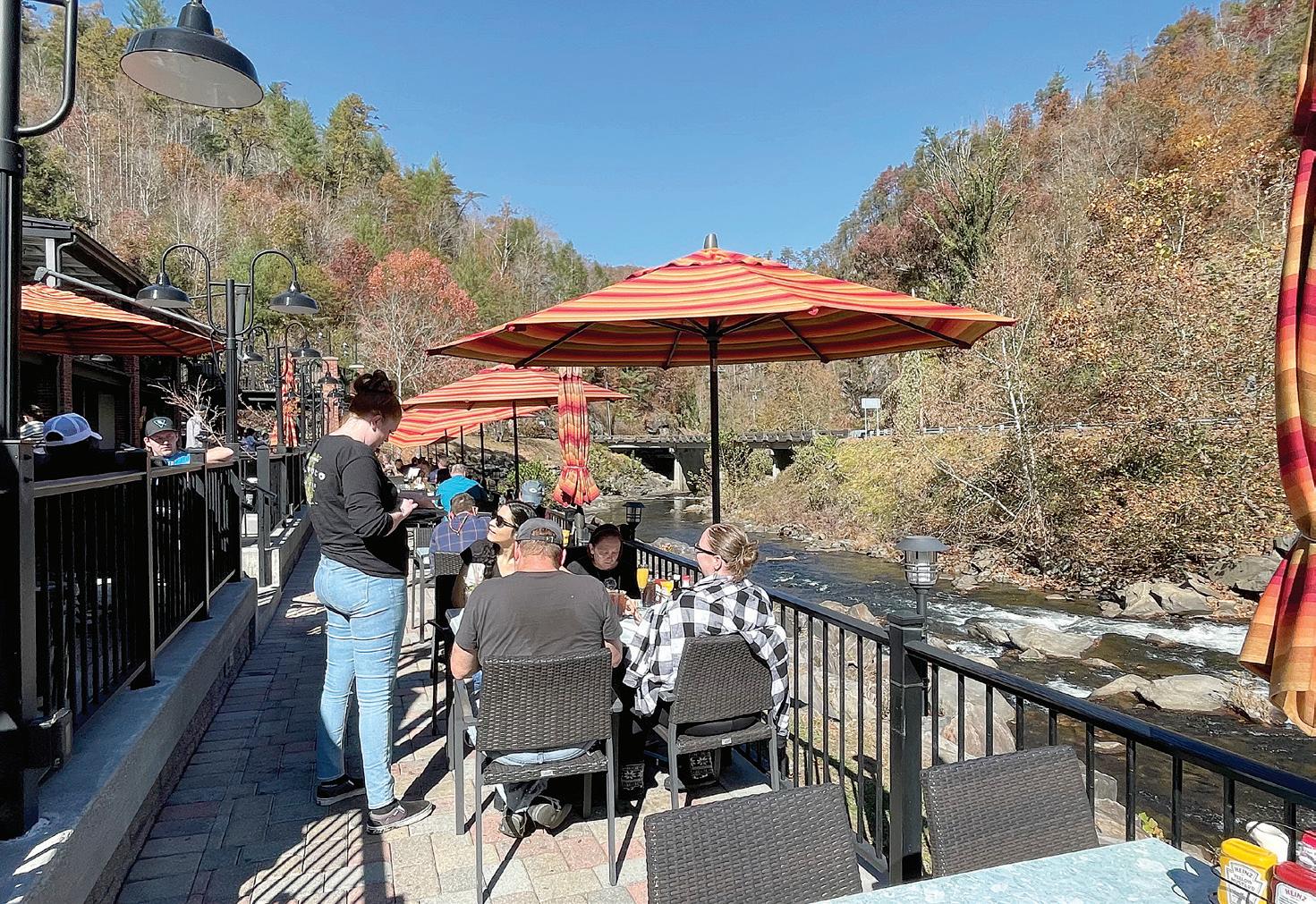
car enthusiasts who drop in for a drink or a meal, leaving their immaculately restored classic cars in the parking lot.
“The food alone is worth a return visit,” my husband Chris said as he bit into his black and blue burger at the Tapoco Tavern as we sat on the huge deck area overlooking the rushing river. Dinner that night was just as delicious and included a ribeye, grilled Carolina trout and fried okra.
High Hampton Resort 1525 Highway 107 S Cashiers, North Carolina 28717 highhampton.com
After the team behind Blackberry Farm purchased the 101-year-old High Hampton and reopened it in 2021, the “Dirty Dancing” vibe is gone along with the buffet meals and rustic dining room furnishings. Meals are now seated and the former allinclusive feature is optional. Along with the Dining Room and The Tavern in the inn, there are three other dining venues: Halsted House, Range House and Mitch’s Lakeside.
High Hampton maintains its vibe of laidback luxury with rocking chairs on the front porch, a huge lobby with a four-sided fireplace and several game tables. We checked out a board game and my husband beat me at “Mystery Date.”
The 1,400-acre property includes a Tom Fazio-designed golf course, lake, pool, children’s activity center, croquet lawn, spa, fitness room, hiking trails and six pickleball courts. Activities on the 35-acre lake in the warm weather include swimming, canoeing, paddle boarding and kayaking.
Accommodations include 18 inn rooms, 40 cottage rooms and three cottages. Our room in the inn had a balcony overlooking the lake, mini fridge, a huge bathroom with a bathtub and two sinks. The dark paneled hallways are lined with historic photos and pages from the original hotel registry books from decades ago.

Brookhaven, Buckhead, Dunwoody and Sandy Springs housing markets remain strong
 By Kathy Dean
By Kathy Dean
Atlanta’s real estate market has been slowed a bit by higher interest rates, but the city’s reputation as a good place to live and do business keeps the homebuyers coming, according to local real estate professionals. In desirable areas like Buckhead, Brookhaven, Dunwoody and Sandy Springs, low inventory has become the norm due to high demand.

According to Monica Parker, Sales
HomeServices, the real estate market in some of Atlanta’s prime neighborhoods continues to be strong and stable as it comes off the highly robust few years, 2020 to 2023.
“In 2023, the rise in interest rates roused a closer look at buying and selling and created a home lock situation. We saw the fourth quarter of 2023 significantly slow down and then pick back up in early 2024,” she said.
Parker shared some detailed market information for April 2024.
■ In Buckhead, new listings were up 38.5% from April 2023 and closed sales increased 6.7%.
■ In Brookhaven, new listings were up 49.4% and closed sales went up 28% year over year.
■ In Dunwoody, closed sales were down 26.8% since the same period in 2023 and new listings were up 88%.
■ In Sandy Springs, closed sales were up 10.2% and new listings were up 13.8% from April 2023.
Elise Baumann
Elise Baumann, Real Estate Professional, Associate Broker, Atlanta Fine Homes Sotheby’s International Realty,

noted that the real estate market has remained robust as we’re moving into the summer season.
“Overall, the current interest rates are not deterring homebuyers who need housing,” she said. “The current buyer pool, regardless of price range, are strong buyers who are well qualified. While the current interest rates may exclude certain buyers from the market, homes that are well-priced continue to sell efficiently.”

“Atlanta was just named the sixth largest metropolitan area in the U.S., according to the new census data so, needless to say, growth is real in all of these areas and demand is high,” said Amy French, Real Estate Agent, Ansley Real Estate | Christie’s International Real Estate.
“We saw a fast and furious first quarter with a slight slowing in the second quarter,” she continued. “With that said, we are still seeing bidding wars and competition for those move-in ready homes that are priced right. Atlanta will always be different temps of HOT.”
French said that higher interest rates have affected the number of buyers making offers. “Instead of five, six, seven offers, we may see two or three,” she explained. “Whether it’s two or 20 offers, it still creates multiple offer scenarios and creates that competitive atmosphere for buyers.”
Low supply and high demand make it a great time to be a seller, French noted. “We have people moving to these hot areas from all over the world, with job opportunities and a desirable lifestyle here,” she said.
Atlanta has been experiencing low housing inventory since before 2020. “What we used to call an ‘inventory crisis’ is now the norm because of our growth and being one of the most desirable cities to live in the Southeast,” she added. “I do not see that changing and so I do not see inventory dramatically increasing any time soon.”






Covers the Buckhead, Brookhaven, Dunwoody and Sandy Springs area (all zip codes)
Homes for sale: 676 units, up 15.4% from previous month, up 56.8% from previous year.
Homes closed: 244 units, no appreciable change from previous month, up 7.5% from previous year.
Homes placed under contract: 229 units, down 10.2% from previous month, down 11.6% from previous year.
Months of inventory based on closed sales: 2.8, up 16.7% from previous month, up 47.4% from previous year.
Statistics from Trendgraphix, provided by Monica Parker, Berkshire Hathaway HomeServices

Parker agreed with the scenario. “Current indications present tight inventory to be expected for the near future and thus will support housing prices to remain steady and strong in these markets,” she said.
Baumann also concurred. “Given the current beat of Atlanta’s market the past few years, I believe it will take years for inventory to increase. I’ve read many different predictions from experts on inventory increasing since this issue began in 2020, and none of them have been correct,” she said.
The key for homebuyers in the market is to be well represented by a seasoned and wellconnected realtor.
“That’s the best way to get access to offmarket properties, see homes quickly and be up to date in what makes a competitive offer,” Baumann advised.



Scan to schedule an appointment


Baumann said she’s eager to see how the market performs in the second half of the year. “I believe well-priced homes, regardless of their price range, will continue to sell efficiently, with savvy buyers who understand the market seizing these opportunities,” she predicted.
According to French, interest rates are expected to start trending down, causing activity to increase significantly across the market. “In any kind of market in Atlanta, if you price right and have a great product, you will do well as a seller, regardless of the rates, because of the low inventory,” she said.
“Additionally — I cannot reiterate this enough — you can refinance your rate when they drop, but you cannot go back and pay less for a house,” French stated.
At the end of last year, the Terry College of Business at Georgia Tech hosted the annual Economic Forecast for 2024. Parker noted that the overall Georgia economy is better in many aspects than the nation’s, as reported by Dean Benjamin Ayers of Georgia Tech.
Additionally, Dean Ayers reported that Site Selection Specialists identified Georgia as the #1 state to do business for 10 straight years. “Bringing it home to Atlanta, 31 Fortune 1000 headquarters are in our Atlanta metro area …As industry thrives, the housing needs remain strong,” Parker said.













